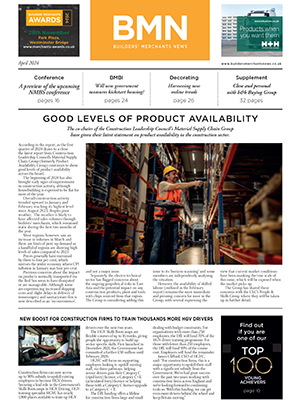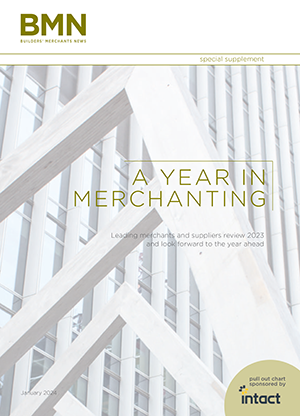In this Builders’ Merchants News report, sponsored by Epicor, our panel discuss how the industry can evolve its business efficiencies through the use of IT and how it can subsequently improve productivity throughout the supply chain.
MEET THE ROUND TABLE PANEL
Lisa Arcangeli, managing editor, Builders’ Merchants News
Peter Buttle, joint managing director, Buttles
Arthur Duffy, regional director distribution, Epicor Software
Kevin Fenlon, chief executive, RGB
Chris Hayward, managing director, NMBS
Tom Mason-Elliott, director, Elliotts
Lisa Arcangeli: Are merchants really making the most of opportunities to develop new revenue streams and back-office systems? Independents, in particular, face major obstacles because of the current fragmented environment. To be productive requires good, solid data, but many companies are not in a position to share data in a meaningful way. Often, there are constraints with IT because of a lack of funds or manpower. There are a raft of issues that need to be addressed.
 Arthur Duffy: Merchants are working hard, but the challenge is that they have gone from a situation where technology and IT has been seen as a necessary evil, instead of something that is important.
Arthur Duffy: Merchants are working hard, but the challenge is that they have gone from a situation where technology and IT has been seen as a necessary evil, instead of something that is important.
The horizon is changing – whether it is customers, suppliers or prospects – there’s a lot of lip service about whether we should do CRM or supply chain management but the question is whether there’s a will within a business to change it. The software is the easy part.
Chris Hayward: The successful implementation of merchants adopting software for their business requires someone to take ownership. I often see cases where people want to put a new computer system in but there’s no one within the business who is driving it or taking responsibility for making it work. It gets pushed around until it falls on some hapless employee who is the last one in the chain to put it in. For smaller merchants this is a problem, because having a dedicated IT person is often beyond their needs. The software company may argue that they don’t need a dedicated individual.
In my experience, if IT is going to be a key part in the business, you should make sure someone is dedicated to it – ensuring that it works and that they test the software. It must be someone who has knowledge and commercial awareness of the business they’re in, making sure that the system fits that business.
There is a requirement now that most merchants make it easy for their customers to go online and place an order. That doesn’t mean internet orders. It means having a facility where customers can log in, access their account information, print copy invoices and statements – bearing in mind that most merchants’ customers will be doing their book-work in the evenings – or their wives will be.
By having the ability to collate orders for collection or delivery in a seamless way, the beauty about login systems is that the pricing can be individual to the customer and you are not competing with other internet companies. Merchants must give their customers this option.
Equally, a bugbear I see as we go forward, is that a lot of business sites are not smartphone-enabled. All you see is a smaller version of what you view on a PC and that is hard to navigate. For a very small investment you can make your website smartphone-enabled, so that it automatically recognises the device that is going to the website and reconfigures the screen accordingly.
Arthur Duffy: Creating a builders’ merchant website is the easy part. You have to decide how much information you want. Many merchants don’t have the in-house expertise. and just see it as an expenseor a cost.
 Kevin Fenlon: When IT was first introduced, it was a case of making it fit around the business. Customer demand has grown and there is much more demand for IT solutions because the people coming into our industry have grown up with this technology.
Kevin Fenlon: When IT was first introduced, it was a case of making it fit around the business. Customer demand has grown and there is much more demand for IT solutions because the people coming into our industry have grown up with this technology.
However, if you go for the real IT expert, they may be very aware, but when it comes to the multitude of disciplines we operate, in terms of pricing, etc, you get resistance because people say ‘he doesn’t understand the industry and how it works’. We’re at a pivotal point: we want the expertise but we don’t want to lose focus of the core part of what we do, which is to trade.
Arthur Duffy: A challenge for the IT industry is that people view software as a commodity. They are used to downloading applications on a smartphone or an iPhone and ask why they cannot also do that with their merchant system. Software is becoming more complex.
Tom Mason-Elliott: The software we use is the mechanism that runs the business. It is through the software that we set the parameters that decide what users can or cannot do and by which they can trade.
It sets a process that we can follow as a business and it gives us a whole range of performance information to determine how we are going to make those decisions, going forward.
That is just at the baseline, before we start talking about the other things we are planning to do – like smartphones or giving our customers more access.
We’re a long way from the days where technology was something we had to have to keep track of stock and invoice people.
Peter Buttle: When we surveyed members of the h&b Group, we found an extraordinarily diverse number of systems for what should broadly be the requirements of all of our members. The software we have has some match-ability to deal with things which we don’t make enough use of, like suggested purchase orders to keep our stock levels more efficient.
Tom Mason-Elliott: Across the industry, everyone is using different software, or if they are using the same software, they’re using it in such a fundamentally different way that we cannot help each other.
Chris Hayward: Suppliers tell merchants their software will do anything they want. And, generally, it can. But, if the process is bad before you computerise, it will be worse when you do.
I have contacted many software companies who provide merchant software and asked them if they could take someone through how they would handle a delivery, place an order or deal with PoDs and none of them have been able to demonstrate how it would handle goods being received, how to allocate goods received and those kinds of things. They are reluctant to say this is how you do it.
Arthur Duffy: It’s not the software provider’s place to say’this is the only way you should do it’. You’re not going to run your business just because the software dictates it. Let’s not forget that if people are using technology, it’s going to give them a a key business differential and they may not be keen to share that.
Kevin Fenlon: We have an aged trading platform and when people have their initial induction, somebody would spend a few hours taking the new person through it. Working on the theory that a person only retains 30% of what they have been taught, when you train the next person, that knowledge diminishes all the time. We probably don’t make use of the full potential of the system.
Chris Hayward: It needs to be simple. My three-year-old boy can work an iPad and most of the software on it. He cannot work a PC because the software is not orientated to make it easy.
 Tom Mason-Elliott: We’re talking about a series of transactions that are incredibly complicated. I can’t think of another industry that allows someone who has worked for the company for two weeks to negotiate price. How, from a transactional point-of-view do you map all of that complexity though the system so that it is tied up in one touchscreen process for an end-user?
Tom Mason-Elliott: We’re talking about a series of transactions that are incredibly complicated. I can’t think of another industry that allows someone who has worked for the company for two weeks to negotiate price. How, from a transactional point-of-view do you map all of that complexity though the system so that it is tied up in one touchscreen process for an end-user?
Peter Buttle: It sounds illogical, but it isn’t. The reason that we don’t have a dominant position like the grocery trade is because there isn’t one price or one product. No one will put their hands up and say ‘here is the generic list and everything else is a generic version of it’.
Tom Mason-Elliott: The complexities work in our favour because they confuse everybody.
Kevin Fenlon: We still have a lot of transactions where customers come in, pick up a product, buy it and walk out. They don’t worry about what happens afterwards. They know they’ll get an invoice and if they have a query about it, they’ll be able to talk to the local representative. We just have to make it easy for the customer to get the order on the system. Then there is an efficiency. At the moment, placing an order means making a phone call, picking up the answer machine message or probably a hand-written note that gets put on to the system.
Arthur Duffy: Ease of use is key if you are trying to give end-users a mechanism to engage with you. If people feel they are not being given exactly what they want at that point, they will go elsewhere.
Tom Mason-Elliott: Do we really think there is potential to sell building products en masse on the internet? Will our customers sit there at 8pm and order all of the products they need for a site and go through translating our system into what they understand?
Kevin Fenlon: There are some people who like to transact in that way. There is demand for services to be more and more available. The traditional contractor used to do a bit of paperwork in the evening, but now he also has to price jobs and search for products. Is he then going to take time to place his order on the system?
Chris Hayward: I visited a merchant before I came here and none of the customers who came in asked about prices. None of the products on display had a price. There was no haggling. They asked a few questions about certain products and the guy behind the counter knew what product was available straightaway. All the customers wanted to do was get served and get out.
Kevin Fenlon: You can open online trading, but once you start the discussion about price, it gets difficult with all the variables that come into the equation.
Chris Hayward: There is a gap in the market and I believe that it will start to be filled with merchants aggressively selling building products on the internet within the next 12 to 18 months. Independents are now gearing up to take part in that market.
Arthur Duffy: Whatever their customer base is, if merchants move across to internet selling, it won’t necessarily be their existing customers who move with them. They will find new audiences.
Tom Mason-Elliott: With the internet, you lose that customer relationship. Yes, you can pick up new customers, but there are differences in the businesses and the relationships we build. I cannot see how we will go about marketing to people we have never met before. I can see big advantages in providing transactional services for our existing customers who value us. But, as soon as you get into general internet trading you find yourself in a price war and it’s very difficult to put a differential on that unless you are talking about delivery terms or discounts.
Chris Hayward: B&Q has chosen Screwfix as its means for selling on the internet. But even Screwfix recognised that only 20% of a builders’ time is planned. That’s why it has opened all these stores – because people want things now, they don’t want to wait until the next day.
 Peter Buttle: That’s why we have an edge. We get an opportunity to deliver service. Due to the difficulties associated with the types of products we deal with, however simple the method of purchasing, we cannot cover all the options with an ‘add to basket’ button. We still need a button on the bottom of the page that says ‘I need to talk to somebody’.
Peter Buttle: That’s why we have an edge. We get an opportunity to deliver service. Due to the difficulties associated with the types of products we deal with, however simple the method of purchasing, we cannot cover all the options with an ‘add to basket’ button. We still need a button on the bottom of the page that says ‘I need to talk to somebody’.
Chris Hayward: Building products lean more towards local service, delivery and local credit. A key benefit to most customers is that builders’ merchants give credit. Customers are looking for a collect and delivery service without having to visit the trade counter. A lot of merchants are already setting up call and collect systems which are working very efficiently, saving time.
If you are selling on the web, you need a different mentality from that of a merchant outlet. You need to understand how to use social media and Google tools in a different way. Many of the more successful internet traders who are merchants have a separate name for their internet sales. This is a sensible route to follow.
Lisa Arcangeli: NMBS has always been a pioneer in the field of IT. Are there ways in which you can help your members to benefit even more?
Chris Hayward: We are in a unique position because we have an external consultant who works one day a week with us. We have been drawing on his expertise. The rest of the time he is a senior lecturer in IT studies at Wolverhampton University. On the back of that, we now have the capability to develop our own apps, which we have done successfully for iPhones, iPads, Blackberrys and Android systems.
We have also developed Merchant Pages – a product database – which has the support of all the major buying groups. We are going to work with these merchant groups to develop a central product database that will be free to use by merchants and suppliers so that they can update their back-office systems. They are, after all, the ones who will get the benefit from the central database. We are also working with United Merchants because we are planning to develop an industry standard.
We can start also using predictive tech-nology, similar to Amazon’s – ‘if you buy one product, why don’t you buy this other one at the same time’. We are building that expertise.
That will lead to a number of good things because once you have the electronic reference point, you can start interrogating the data and categorising it and drilling down on it in a meaningful way.
Kevin Fenlon: A manufacturer only wants to produce the widgets he can sell. He produces them and has a history of what we have bought. What we want is a history of what we have sold, so we can compare notes. That means you need standard coding. And, it means the manufacturer can know what demand – or not – there is. He doesn’t want to be holding stock and we don’t want to be holding stock we cannot sell. If we can enhance that relationship between supplier and merchant, we are all winners.
 Chris Hayward: We could easily write a piece of software that could issue stock information and merchants’ sales data and put it out into the cloud or into a hub, where that information could be interrogated by suppliers. They could see what they are selling regionally or locally and what the stock levels are. That would help drive more sales for everybody, going forward. In terms of technology, it is easy to do.
Chris Hayward: We could easily write a piece of software that could issue stock information and merchants’ sales data and put it out into the cloud or into a hub, where that information could be interrogated by suppliers. They could see what they are selling regionally or locally and what the stock levels are. That would help drive more sales for everybody, going forward. In terms of technology, it is easy to do.
This article first appeared in the December 2012/January 2013 issue of Builders' Merchants News.






